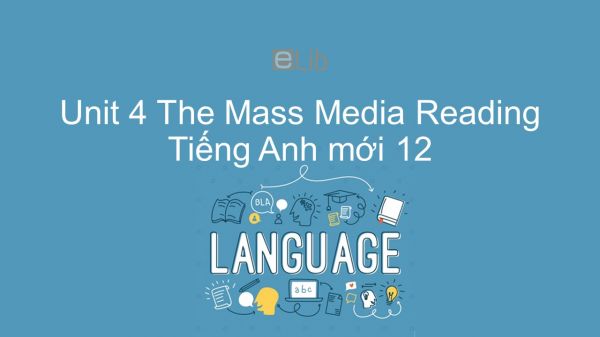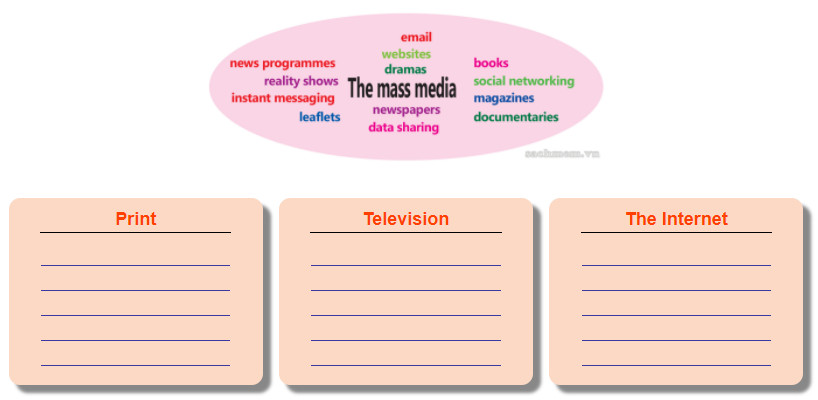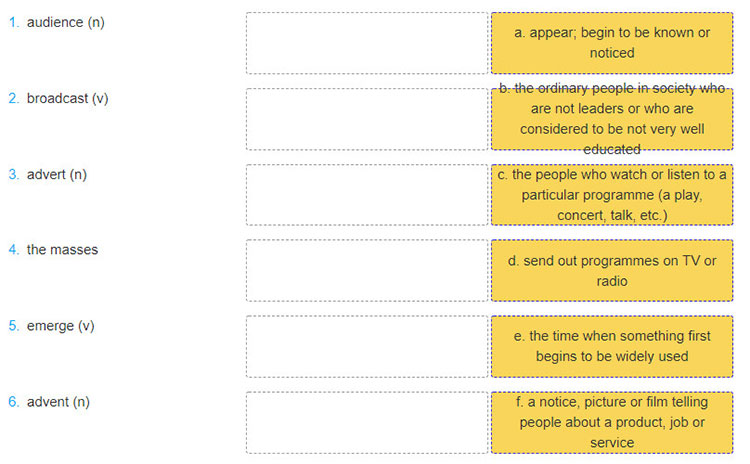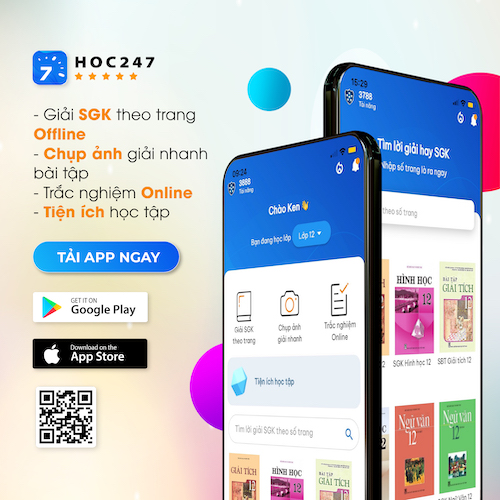Unit 4 lớp 12: The Mass Media - Reading
Bài học Unit 4 Lớp 12 mới phần Reading hướng dẫn các học tìm hiểu bài đọc về Các hình thức truyền thông đại chúng thông qua một số dạng bài tập khác nhau. Mời các em cùng tham khảo!
Mục lục nội dung

Unit 4 lớp 12: The Mass Media - Reading
Mass media forms (Các hình thức truyền thông đại chúng)
1. Task 1 Unit 4 lớp 12 Reading
Work in pairs. Put the words and phrases related to the mass media in three groups: print, television and the Internet. Use a dictionary to look up unfamiliar words. (Làm việc theo cặp. Đặt các từ và cụm từ liên quan đến các phương tiện truyền thông đại chúng trong ba nhóm: in, truyền hình và Internet. Sử dụng từ điển để tra các từ lạ.)

Guide to answer
Print: books, magazines, leaflets, newspapers (In: sách, tạp chí, tờ rơi, báo )
Television: news programmes, dramas, reality shows, documentaries (Truyền hình: chương trình tin tức, phim truyền hình, chương trình thực tế, phim tài liệu)
The Internet: email, websites, instant messaging, data sharing, social networking (Internet: email, trang web, nhắn tin nhanh, chia sẻ dữ liệu, mạng xã hội.)
2. Task 2 Unit 4 lớp 12 Reading
Quickly read the text and choose the best heading. (Nhanh chóng đọc các văn bản và chọn tiêu đề hay nhất.)
a. The history of print media (Lịch sử các phương tiện truyền thông)
b. Forms of mass media (Các hình thức truyền thông đại chúng)
c. The advent of the Digital Media Age (Sự ra đời của thời đại truyền thông kỹ thuật số)
d. Means of mobile communication (Ý nghĩa của phương tiện liên lạc di động)
The mass media are means of communication, such as books, newspapers, recordings, radio, movies, television, mobile phones and the Internet, that can reach a large audience.
Although the first printed books had appeared long before in China, the term ‘mass media ’ we use today was coined with the creation of print media, which started in Europe in the Middle Ages. This is also considered the first example of mass media due to the large number of readers then.
Since the mid-twentieth century, new technologies have been developed, which helped to diversify mass media and make them an inseparable part of our lives. The role of the mass media is not only to entertain and amuse the masses. Its most important role is to provide information and news about events in different parts of the world as they occur. Educating people about their rights and responsibilities is another function of mass media.
Until recently, mass media forms were classified into six categories according to the sequence of their advent: print, recordings, cinema, radio, television and the Internet. Each form has its own characteristic content types, creative artists and business models. In the early 21st century, with the explosion of mobile communication technology, the mobile phone has emerged as a new and unique media channel. Video and computer games have also developed into a mass media form.
The Internet and mobile communication is now the most popular means of receiving information and interacting with people through email, instant messaging, apps, search engines, blogs. social networks and other services. Most print and broadcast media have a presence on the web by having video adverts or Quick Response Codes (QR Codes) that link to specific websites.
Each form of mass media has had an important impact on society, for example, books have helped people to educate themselves while newspapers have recorded daily events. Magazines were the first visual medium before the advent of television, which together with radio, brought entertainment and news programmes into people's homes. However, all these media had to change and adapt to the advent of the Internet and Digital Media Age. New digital media forms are more personal and social as they allow people to connect with each other, collaborate and share information and personalise their experiences.
Guide to answer
b. Forms of mass media
Tạm dịch
Các phương tiện thông tin đại chúng là phương tiện truyền thông, như sách, báo, đài phát thanh, phim ảnh, truyền hình, điện thoại di động và Internet, có thể tiếp cận được nhiều đối tượng.
Mặc dù cuốn sách in đầu tiên đã xuất hiện từ lâu ở Trung Quốc, nhưng thuật ngữ 'phương tiện thông tin đại chúng' mà chúng ta sử dụng ngày nay được đặt ra với việc tạo ra các phương tiện in, bắt đầu ở châu Âu vào thời Trung Cổ. Đây cũng là ví dụ đầu tiên của các phương tiện thông tin đại chúng dựa theo số lượng lớn độc giả.
Kể từ giữa thế kỷ XX, công nghệ mới đã được phát triển, giúp đa dạng hóa các phương tiện thông tin đại chúng và biến chúng thành một phần không thể tách rời của cuộc sống chúng ta. Vai trò của các phương tiện thông tin đại chúng không chỉ là để giải trí và giải trí cho quần chúng. Vai trò quan trọng nhất của nó là cung cấp thông tin và tin tức về các sự kiện ở những nơi khác nhau trên thế giới khi chúng xảy ra. Giáo dục người dân về quyền và trách nhiệm của họ là một chức năng khác của các phương tiện thông tin đại chúng.
Cho đến gần đây, các hình thức truyền thông đại chúng được phân loại thành sáu loại theo trình tự của sự ra đời của chúng: in ấn, ghi âm, rạp chiếu phim, đài phát thanh, truyền hình và Internet. Mỗi hình thức có các loại nội dung đặc trưng riêng, nghệ sĩ sáng tạo và mô hình kinh doanh. Vào đầu thế kỷ 21, với sự bùng nổ của công nghệ truyền thông di động, điện thoại di động đã nổi lên như một kênh truyền thông mới và độc đáo. Trò chơi video và máy tính cũng đã phát triển thành một hình thức truyền thông đại chúng.
Internet và truyền thông di động bây giờ là phương tiện phổ biến nhất để nhận thông tin và tương tác với mọi người thông qua email, nhắn tin tức thời, ứng dụng, công cụ tìm kiếm, blog, mạng xã hội và các dịch vụ khác. Hầu hết các phương tiện truyền thông in ấn và quảng cáo đều có mặt trên web bằng cách quảng cáo video hoặc mã đáp ứng nhanh (QR Codes) liên kết tới các trang web cụ thể.
Mỗi hình thức truyền thông đại chúng đã có tác động quan trọng đến xã hội, ví dụ như sách đã giúp mọi người tự giáo dục bản thân trong khi báo chí ghi lại các sự kiện hàng ngày. Tạp chí là môi trường thị giác đầu tiên trước khi truyền hình, cùng với đài phát thanh, đưa các chương trình giải trí và tin tức vào nhà của người dân. Tuy nhiên, tất cả các phương tiện truyền thông này đã phải thay đổi và thích nghi với sự ra đời của Internet và Thời đại Truyền thông Kỹ thuật số. Các hình thức truyền thông kỹ thuật số mới có tính cách cá nhân và xã hội hơn khi họ cho phép mọi người kết nối với nhau, cộng tác và chia sẻ thông tin cá nhân và cá nhân hoá trải nghiệm của họ.
3. Task 3 Unit 4 lớp 12 Reading
Match each of the following words with its meaning. Use a dictionary if necessary. (Nối mỗi từ sau đây với ý nghĩa của nó. Sử dụng từ điển nếu cần thiết.)

Guide to answer
1-c.
(khán giả - những người xem hoặc nghe chương trình)
2-d
(phát sóng - chiếu các chương trình trên TV hoặc đài)
3-f
(quảng cáo - một thông báo, hình ảnh, hoặc phim giới thiệu với mọi người về một sản phẩm, công việc hoặc dịch vụ)
4-b
(quần chúng - những người bình thường trong xã hội không phải là những người lãnh đạo hoặc những người được coi là không được giáo dục tốt)
5-a
(nổi lên - xuất hiện, bắt đầu được biết đến hoặc nhìn nhận)
6-e
(phát hiện - một thời gian khi cái gì đó bắt đầu được sử dụng rộng rãi)
4. Task 4 Unit 4 lớp 12 Reading
Read the text again. Decide if the following statements are true (T), false (F), or not given (NG). Tick the correct box (Đọc văn bản một lần nữa. Quyết định xem các nhận định sau đây là đúng (T), sai (F), hoặc không xác định (NG). Đánh dấu vào ô đúng)
Guide to answer
1 – F. Mobile phones and the Internet are the only forms of mass media. (Điện thoại di động và Internet là những hình thức duy nhất của các phương tiện thông tin đại chúng.)
2 – T. The role of mass media is to entertain, amuse, inform, educate and unite people. (Vai trò của các phương tiện thông tin đại chúng là để giải trí, vui chơi, thông tin, giáo dục, và gắn kết mọi người.)
3 – F. The mobile phone is regarded as a unique means of communication. (Điện thoại di động được coi là một phương tiện giao tiếp độc đáo.)
4 – T. People nowadays prefer instant messaging and social networking to emails. (Mọi người ngày nay thích tin nhắn nhanh và mạng xã hội hơn là thư điện tử.)
5 – NG. Only digital media have influenced people's lives and society. (Chỉ có phương tiện truyền thông kỹ thuật số mới có ảnh hưởng đến cuộc sống của người dân và xã hội.)
5. Task 5 Unit 4 lớp 12 Reading
Work in pairs. Tell each other about the forms of mass media that you use every day. Explain how you benefit from using them. (Làm việc theo cặp. Nói về các hình thức truyền thông đại chúng mà bạn sử dụng hàng ngày. Giải thích cách bạn được hưởng lợi từ việc sử dụng chúng.)
Guide to answer
- the forms of mass media that I use everyday: TV, mobile phone, Internet... (Hình thức truyền thông mà tôi sử dụng hàng ngày: TV, điện thoại di động, Internet ...)
- Benefit: to entertain, amuse, inform, educate and unite others. (Lợi ích: để giải trí, để vui chơi, thông tin, giáo dục , và gắn kết với người khác...)
6. Practice Task 1
Read the following passage and mark the letter A, B, C, or D on your answer sheet to indicate the correct answer to each of the questions.
Researchers in the field of psychology have found that one of the best way to make an important decision, such as choosing a university to attend or business to invest in, involves the utilization of a decision worksheet. Psychologists who study optimization compare the actual decisions made by people to theretical ideal decisions to see how similar they are. Proponents of the worksheet procedure believe that it will yield optimal, that is, the best decisions. Although there are several variations on the exact format that worksheets cam take, they are all similar in their essential aspects.
Worksheets require defining the problem in a clear and concise way and then listing all possible solutions to the problem. Next, the pertinent considerations that all possible solutions to the problem. Next, the pertinent considerations that will be affected by each decision are listed, and the relative importance of each consideration or consequence is determined. Each consideration is assigned a numerical value to reflect its relative importance. A decision is mathematically calculated by adding these values together. The alternative with the highest number of points emerges as the best decision.
Since most important problems are multifaceted, there are several alternatives to choose from, each with unique advantages and disadvantages. One of the benefits of a pencil and paper decision-making procedure is that it permits people to deal with more variables than their minds can generally comprehend and remember. On the average, people can keep about seven ideas in their minds at once. A worksheet can be especially useful when the decision involves a large number of variables with complex relationships. A realistic example for many college students is the question "What will I do after graduation?" A graduate might seek a position that offers specialized training, pursue an advanced degree, or travel abroad for a year.
A decision-making worksheet begins with a succinct statement of the problem that will also help to narrow it. It is important to be clear about the distinction between long-range and immediate goals because long-range goals often involve a different decision than short-range ones. Focusing on long-range goals, a graduating student might revise the question above to "What will I do after graduation that will lead to a successful career?"
Question 1: According to decision-worksheet theory, an optimal decision is defined as one that
A. has the fewest variables to consider
B. uses the most decision worksheet
C. has the most points assigned to it
D. is agreed to by the greatest number of people
Question 2: Which of the following terms is defined in the passage?
A. Proponents B. Optimal C. Variables D. Long-range goals
Question 3: The word "essential" in paragraph 1 is closest in meaning to
A. introductory B. fundamental C. changeable D. Beneficial
Question 4: The author states that "On the average, people can keep about seven ideas in their minds at once" (paragraph 3) to explain that
A. people can learn to keep more than seven ideas in their minds with practice
B. most decisions involve seven steps.
C. human mental capacity has limitations.
D. some people have difficulty making minor as well as major decisions.
Question 5: The word "it" in paragraph 4 refers to
A. worksheet B. problem C. distinction D. decision
Question 6: What does the passage mainly discuss?
A. A comparison of actual decisions and ideal decisions.
B. Research on how people make decisions.
C. A tool to assist in making complex decisions.
D. Differences between long-range and short-range decision making.
Question 7: Of the following steps, which occurs BEFORE the others in making a decision worksheet?
A. Listing the consequences of each solution.
B. Writing down all possible solutions.
C. Deciding which consequences are most important.
D. Calculating a numerical summary of each solution.
7. Practice Task 2
Read the following passage and mark the letter A, B, C, or D on your answer sheet to indicate the correct answer to each of the questions.
“When a snow leopard stalks its prey among the mountain walls, it moves softly, slowly,” explains Indian biologist Raghunandan Singh Chundawat, who has studied the animal for years. “If it knocks a stone loose, it will reach out a foot to stop it from falling and making noise.” One might be moving right now, perfectly silent, maybe close by. But where? And how many are left to see?
Best known for its spotted coat and long distinctive tail, the snow leopard is one of the world’s most secretive animals. These elusive cats can only be found high in the remote, mountainous regions of central Asia. For this reason, and because they hunt primarily at night, they are very rarely seen.
Question 1: Which of these is NOT true about the Himalayan Homestays program?
A. The organization helps herders to build fences.
B. Herders provide accommodation to guests.
C. Some herders work as nature guides.
D. Visitors pay $10 a week to stay at a herder’s house.
Question 2: The purpose of the projects mentioned is
A. to persuade herders to live on eco-tourism not raising animals
B. to elevate the status of the women in the communities
C. to increase the population of snow leopards in wildlife reserves
D. to make local people have a sustainable life to protect snow leopards
8. Conclusion
Kết thúc bài học, các em cần luyện tập đọc hiểu và ghi nhớ các từ vựng sau:
- audience
- broadcast
- advert
- the masses
- emerge
- advent
Tham khảo thêm
- doc Unit 4 lớp 12: The Mass Media - Getting Started
- doc Unit 4 lớp 12: The Mass Media - Language
- doc Unit 4 lớp 12: The Mass Media - Speaking
- doc Unit 4 lớp 12: The Mass Media - Listening
- doc Unit 4 lớp 12: The Mass Media - Writing
- doc Unit 4 lớp 12: The Mass Media - Communication and Culture
- doc Unit 4 lớp 12: The Mass Media - Looking Back
- doc Unit 4 lớp 12: The Mass Media - Project




